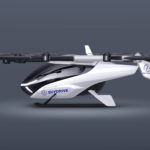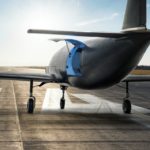Sabrewing’s RH-1-A Rhaegal (pronounced “Rye-gull”) air cargo drone has achieved its first hover flight while lifting a record-setting payload.
The pre-production air vehicle, also known as the RG-1-A “Alpha” model, was able to lift 829-pound (374 kg) payload, breaking the previous world record for the “dead-lift” of any commercial, vertical takeoff, uncrewed air vehicle (UAV).
The Rhaegal “Alpha” aircraft is an autonomous cargo aircraft capable of both vertical and conventional take-off.
“We are extremely proud to have accomplished this milestone,” said Ed De Reyes, chairman and CEO of Sabrewing.
“It’s been a long journey to get here, but we were unwilling to compromise safety or design. Our design and tests teams – and our development partners – invested tens of thousands of hours to make this milestone such a history-making success.”
Design improvements
Improvements to the blades, ducts, and shape of the shroud of the aircraft’s ducted fans allowed each duct to produce 30 per cent more thrust than it was originally designed to provide.
The pre-production prototype aircraft weighed just over 2,700 pounds (1,225 kg) for the first flight and is capable of a maximum gross weight (with payload) of up to 3,100 pounds (1,406 kg) at altitudes up to 22,000 feet (6700 meters) and 200 knots.
When taking off conventionally, this aircraft has enough thrust to carry over 2 tons of cargo with the same range, altitude and speed.
“This is only a fraction of what this aircraft can carry. But it proves that we’re able to lift more cargo on our maiden flight than any previous cargo UAV that has ever flown,” said De Reyes.
The Rhaegal aircraft uses a turbo-electric drivetrain based on Safran’s Helicopter Engines turbine-based motor, the Ariel 2E. The Ariel can use 50 per cent sustainable aviation fuel (SAF), and turns an electric generator which produces nearly 1 megawatt of electric energy which in turn then powers electric motors in each of the four ducted fans.
Subscribe to the FINN weekly newsletter

